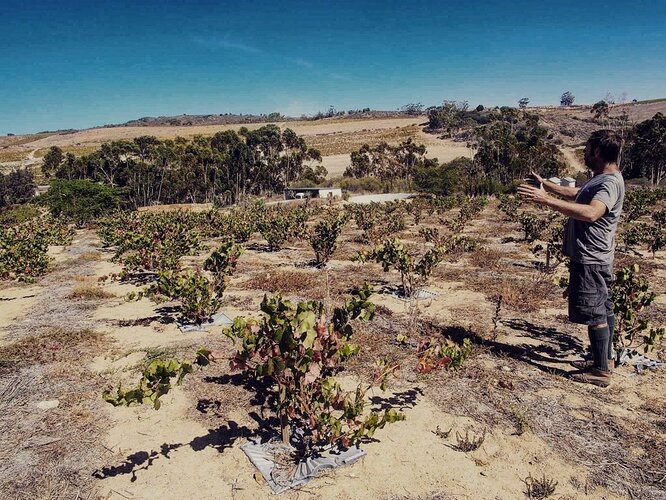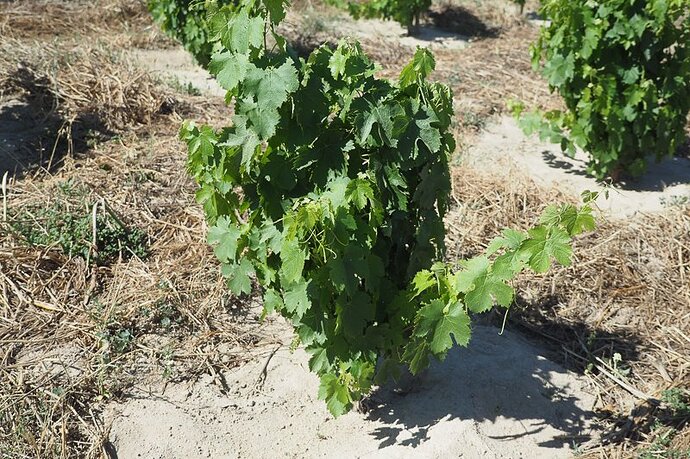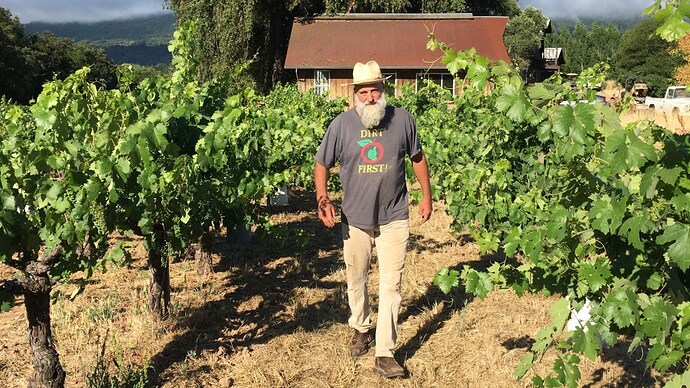I don’t know a whole lot about about dry farming and would love to learn more. I am curious how folks have been coping with the drought at hand. What is the threshold for dry farming currently and if conditions were to persist into the next season? Any insight would be greatly appreciated.
Not a farmer, but the dry-farmed vineyards I’ve visited this year are all doing fine. In fact, while expecting a smaller crop due to drought, that doesn’t actually seem to be what the vines are thinking. When talking to the growers about it, of course they are all stressed, but most of these vineyards are 50-100+ years old, and have seen it all before.
While our rainfall totals are really low for the winter, we were lucky that we did get some significant rain just before budbreak which I’m sure helped mitigate the issue.
I think I’m understanding your question here Robert. The largest constraint with dry farming is yield. Dry farming typically necessitates lower density of plantings which lowers yields per acreage. Vine growth and fruit set / berry size also seems to self-regulate as well in absence of regular irrigation. I figure that means less green harvesting in the vineyard.
As with many things, economics figure greatly into dry farming as well. In Napa, the sky-high prices of land and fruit typically require greater yield per acre. Cabernet is typically planted denser and regularly irrigated in order to create greater yield per acre without having to obtain larger yield per vine. In many years, this would be impossible to do through dry-farming and the cost of water is typically less than the opportunity cost of lower yields. In order to create a particular style, some producers may have extensive berry selection or saignee (bleeds) in order to create greater concentration which exacerbates lowers yields (making greater yield per acre - not vine - more necessary).
In other regions like Sonoma, Lodi and Paso Robles, there’s greater acreage of dry-farmed vineyards for a variety of reasons. In the case of Sonoma and Lodi (and to a lesser extent Paso Robles) there’s a great deal of older vineyards that were planted decades ago. (particularly mixed-blacks, zinfandel, etc). By this point, the vines are likely deeply rooted and mostly acclimated to drought years due to their ability to reach deep into the water table. In conjunction with vine age and dry-farming, these vineyards create wines of greater quality and character.
In Paso Robles, dry farming is done partially due to limited resources (lack of water) but also because some of the varieties are better suited for dry farming. Grenache, for example, is vigorous with larger yields and dry-farming can help temper its vigor leading to higher quality and more interesting character. Rhone varieties in general are more adapted to drier climates which makes dry-farming more feasible and given the economics of some of these sites, lower yields with higher quality is economically sustainable. While property costs are going up here, the available land and existing sites allow for less-denser planting too. Soil profile is also important as well - limestone in Paso Robles retains water better than other soil types and this allows greater availability of moisture.
As for successive drought years, some dry-farmed vineyards still have the irrigation infrastructure in place (typically drip irrigation) and will irrigate in extreme cases using water water from wells or storage basins/ponds on site.
There was a good article on this from Wines and Vines a few days ago.
http://www.winesandvines.com/template.cfm?section=features&content=51150
Our many dry-farmed vineyards are holding up remarkably well this year. Even at Bedrock Vineyard where we have drip we have not had to irrigate once this year after many years of soil work (increased organic content adds water holding capacity).
I am interested in learning about the principles and practice of dry farming that are relevant to CA.
Can anyone recommend some reliable introductory reading material?
Technical is ok but I am mostly looking for a practical foundation.
The Tablas Creek blog is a great source to understand a grower/producer’s perspective, with respect to the challenges of applying specific farming practices (like dry-farming):
· "Dry-Farming in California’s Drought, Part 1: Understanding California’s Only-Sorta-Mediterranean Climate"
May 5, 2015
· "Dry-Farming in California’s Drought, Part 2: Looking Forward to the Past"
May 15, 2015
· "Dry Farming in California’s Drought, Part 3: How We Got Here (and Where We Go Next)"
May 26, 2015
Thanks Drew. Part 2 is interesting but I am really looking for something more detailed and technical.
Perhaps someone with farming or vineyard management expertise will be able to point me in the right direction.
Grape-growing without irrigation may be better understood by observing strategies practiced in locations outside of the US, like South Africa.
Eben Sadie recently established a vineyard in which has never received irrigation. This Swartland-based project coincided with a multi-year drought, which intensified the challenges of keeping the young plants alive.
An eclectic selection of winegrape cultivars is growing in Sadie’s test site. Environmentally friendly viticultural practices are the keystone of a presumably expensive effort.
Wine Anorak
“In the Swartland with Eben Sadie (1), The Vineyard”
by Jamie Goode
April 7, 2020
"…In November 2019, Ring and I visited [Eben Sadie] at his farm in the Paardeberg, in South Africa’s Swartland. We began with a viticultural masterclass walking in his home vineyard of Aprilskloof in the Paardeberg as he discussed his approach to farming.
"…One major theme for him has been climate change. ‘It has been a major topic. There are definitely areas in the world that are more prone to be affected. Look at areas in Australia, and here in the Swartland. These places that are already warm and dry will be the first to face the full wrath of the storm.’ He reckons that the key thing in the light of climate change is to farm well to protect resources, and to be sustainable. ‘One of the reasons I love the Swartland is not the lack of water, but because it is not a vastly irrigated area,’ he says.
“‘This vineyard isn’t irrigated and it was planted in the height of the drought,’ he says. ‘The biggest drought in a century. It is now four years old and it has only known the drought’…”.
Jaime Goode YouTube video
“Eben Sadie on Viticulture”
April 6, 2020
Wine Anorak
“Eben Sadie and Columella”
by Jamie Goode
2012
“…‘I decided to work in the Swartland for three or four main reasons. It is not the best known region in South Africa, but it is definitely the area with the most interesting soils. It has the poorest soils, no water (no irrigation) and it also has the highest per capita of old vineyards in the country. And there are not a lot of people. It is an area that can produce incredibly high quality fruit. We wanted to just harness all this and bring it together’…”.
Wine Sprudge
“Swartlandia: Walking the Vines with South African Winemaker Eben Sadie”
by Christina Rasmussen
June 26, 2018
"…Sadie is world-renowned for his work reviving old vineyards. But here, on this plot, he is building something new. Here are vines of Garnacha Tintorera with massal and clonal selections of Cinsault. This is crucial to ensure field diversity and to study vines and wine. After all, Eben is interested in the truth, not just back-label stories.
“For the same reason, he is planting a vast diversity of grape varieties, out of deep curiosity for what will suit these soils and climate. The list extends to massal and/or clonal selections of Carignan, Grenache, Terret Noir, Counoise, Negroamaro, Aglianico, Agiorgitiko, Tinta Francesca, and Bastardo, to name a few.”
"…His baby vines, here on decomposed granite, are planted to 1,350 vines per hectare. Each vine is planted with a little square shape called an Altyas*, which provides a dynamic, 360-degree space. These conserve soil moisture, prevent the growth of competitive weeds, translocate rain to their roots and homogenize soil temperature for better root growth development. All of Sadie’s vines, whether young or old, are dry farmed, which is crucial. ‘The moment you start irrigating, the vintage is nullified,’ he says. ‘Life’s tough. You’d better get used to it quick.’
“…‘The Swartland caught me,’ he says. ‘20 years ago, I didn’t believe that the wine or the soil here was better - you must always be honest about yourself and about wine - but, I came back here for the soils, the vast amount of old vines, no water, no irrigation, and no people,’ at this he chuckles. ‘I always wanted to find something that I love as much as I love surfing. I have that here’…”.
\
- I cannot find anything on the internet - or elsewhere - that explains fully what “Altyas” are.
Wine
“Tim James: Eben Sadie, Grape-Grower”
by Tim James
June 28, 2021
"…Farming is clearly what Eben loves most of all. He has a highly accomplished winemaker in the cellar, Paul Jordaan, and clearly, he’d like to spend as much time as possible among the vines - not only those he owns but those he has on lease and whose viticulture he controls; that is 42 of the 48 vineyards he currently works with. He now has a team of 18 permanent vineyard workers, as well as viticulturist Morné Steyn on the job.
"But if any Sadie-grown grapes get sold to other winemakers, you can be sure that they will come expensive (at least once the vines mature). Not because of greed, but because Eben’s way of farming is very costly. We had a conversation about this while he was explaining the way he is planting his new 3.6-hectare mixed vineyard (including Agiorgitiko, Trincadera, Tinta Francesca, Cinsault Blanc, Vermentino, Grillo, Clairette, Palomino, Lledoner Pelut, a little Syrah despite Eben having clearly rather fallen out of love with the grape, and - perhaps most excitingly - the cleaned-up Pontac that is becoming available). Each vine has its own pole, but essentially, as I understand it, each will be rather like a bushvine with a trunk holding it well off the ground. The first, red-wine, vineyard on Rotsvas was of more standard bushvines, but the second, for white-grape wines, was also of this higher form of head-trained vines (though on slightly shorter poles because there is less vigour in the soil). It’s a system, which Eben thinks is particularly well suited to increasingly dry Swartland conditions without irrigation.
"Look at the Rotsvas vineyards and you see a vast amount of mulching with straw – an expensive matter (though at least transport costs for it are lower in the Swartland, where so much is produced). It’s part of an expensive programme of hands-on care for the vines. On a side note: that cost doesn’t necessarily include the use of horses in working the vineyard.
"…The cost of high-quality grape farming is now up to about R85 000 per hectare [equivalent to $5,803.95/hectare, or $14,341.87/acre], Eben reckons, meaning a break-even price of R14 000 per ton [equivalent to $955.94/ton].
“…Eben, as a potential grape farmer selling off expensively-produced grapes, would obviously be aiming at those wanting really high-end fruit…But the effort, and the goal of helping to further develop Cape viticulture at the highest level, is a fine and important one.”
Ex Animo Wine Co Podcast
“Episode #1440: Eben Sadie, Sadie Family Wines”
April 22, 2020
Length: 1:37:21
Sadie Family Wines website:
**In Bucklin Vineyards’ Spring 2022 release email, owner Will Bucklin reflected on the question of dry-farming amidst California’s ongoing drought.
He does not condemn dry-farming out of hand. Rather, Mr Bucklin identifies its influence on other elements of agriculture and soil health.
Sustainable viticulture considers the interdependent relationships between nature and grape cultivation. Rigid dogmatism rarely meshes with real-world situations.
In point of fact, many professed “dry” growers provide some water to their vines each year - particularly between harvest and budbreak.**
"Bucklin Vineyards 2022 Spring Release Email:
March 1st, 2022
“'Anxiety is a waste of imagination’ - Will”
"The 2021 harvest season ended with an atmospheric river that delivered 8 inches of rain on October 24th. I am fond of saying I would prefer to die from drowning than to die of thirst, but so much rain on parched, drought-stricken soil has a tendency to run off instead of soak in. Nonetheless, it was a hard finish to the season and a welcome respite from fall firestorms.
"November continued apace, delivering storm after storm but, starting December, the spigot turned off and we have not seen a drop since. The consensus is that we will see 60 days of winter with no rain. A ‘miracle March’ is our hope, but hope does not pay the bills, so we have already mowed our cover crops in an effort to preserve what moisture we have left in the ground.
"We haven’t mowed, much less driven a tractor in the vineyard this early in the season. With regards to dry farming, the sooner we mow and the sooner we till, the more water we will lock in the soil for the vines. The question is: do we till now or wait and hope for more rain and more time for our cover crops to grow.
"I am beginning to wonder if dry-farming in a warming and drying climate is becoming a fool’s errand.
“Furthermore, I am wondering if the judicious application of irrigation might be a more benign farming practice, while also allaying some of the anxiety that comes with relying on rain.”
Image: “Will walking in his field blend vineyard”
Photo: Jonah Raskin
"Over the decades we have worked to increase our soil organic matter with annual compost applications and by growing robust cover crops during the winter months. The benefits have been evident via lab tests, increased yields, and, of course, our lush cover crops.
"However, dry-farming, by its nature and tradition, is counterproductive to building up organic matter because of its reliance on tillage. Quite simply, tillage destroys organic matter by aerating the soil which in turn oxidizes the organic matter back into C02.
"This begs the question: why not stop tillage? The answer is that it takes years to build organic matter but only days to till. Tillage preserves moisture in the short term, at the expense of accumulating organic matter that can preserve moisture in the long term. It is a catch-22.
"This past year, I have been visiting vineyards while trialing various tools and even bringing animals on-farm to see if they could play a role. The plan that has resulted will be to introduce irrigation in a few blocks that will not be tilled. We will monitor the organic matter and vine health with the hope that we can eventually wean the vines off of water.
“No-till agriculture does not mean we just sit on our thumbs and magic happens. It is a different way of approaching the annual cycle of farming and it requires a different set of tools to do it successfully. The holy grail would be to profitably make delicious wine without irrigation or tillage. Well actually, the holy grail would be farmers across the planet working in concert to get carbon back in the ground, while working smarter with fewer inputs, all the while enjoying the fruits of our labor.…”.
Bucklin Vineyards WordPress
“It Is Not a ‘Miracle’”
September 1, 2016
Slow Food Russian River
“‘Old Hill Ranch’ & Will Bucklin: Good, Clean & Fair”
by Jonah Raskin
July 1, 2017
Online Resources: Dry-Farming:
ARC GIS
Story Map: “Groundwater: Understanding and Managing This Vital Resource”
CA Depart. Water Resources
Community Alliance with Family Farmers (CAFF)
“Dry Farming Wine Grapes: A Best Management Practice Guide for California Growers” (PDF Download)
by Kendall Lambert
May, 2015
Encyclopedia of the UN Sustainable Development Goals
“Climate Change and Water Management: Non-viability of Freshwater Irrigation in Viticulture”
by Linda Johnson-Bell
Published by Springer Nature, Switzerland (2019)
Editors: Filho W. Leal, A.M. Azul, L. Brandli, P.G. Özuyar, T. Wall
Google Books
Dry-Farming: Its Principles and Practice
by William Macdonald
Published by Century Company (1909)
California Agricultural Water Stewardship Initiative
“Dry Farming”
CA Dept. of Water Resources
“Sustainable Groundwater Management Act (SGMA)”
In my vineyard, it’s just a function of soil depth/water holding capacity. The part of the vineyard that I dry farm is flatter ground with deeper soil. Even with a moderately devigorating rootstock (101-14) it’s generally fine without irrigation. The steeper part of the vineyard has a slightly more aggressive rootstock (3309) but the soil is still too shallow to dry farm. Quality-wise, it’s the opposite of what is commonly supposed – the irrigated sections are preferred.
The following article offers differing perspectives on dry-farmed vineyards versus those where irrigation is employed. A handful of vintners and growers contribute their viewpoints on the matter.
Wine Enthusiast
“Do Dry-Farmed Vines Make Better Wine?”
by Stacy Briscoe
February 10, 2023



